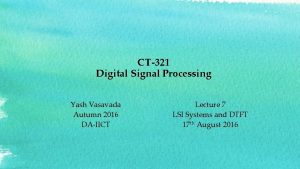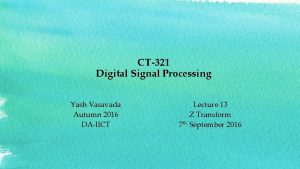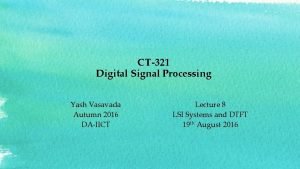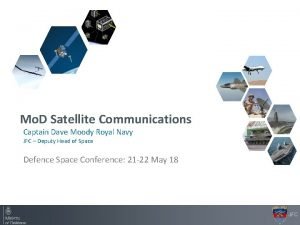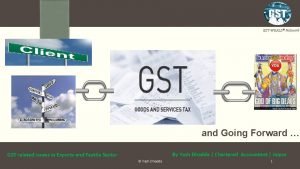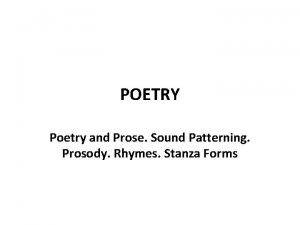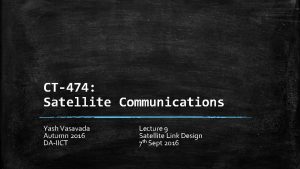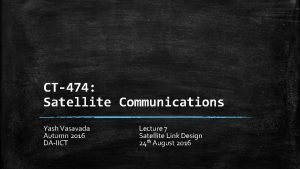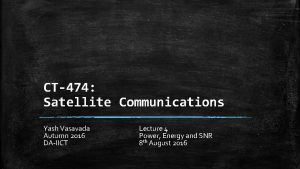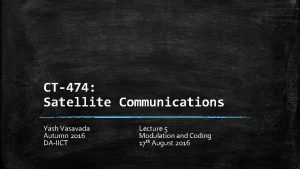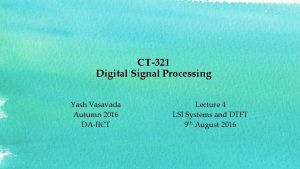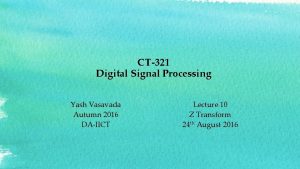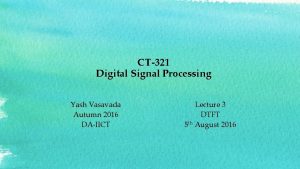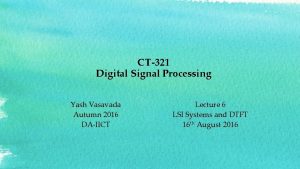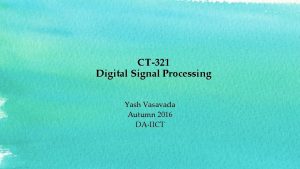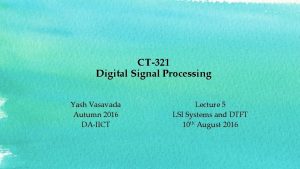CT474 Satellite Communications Yash Vasavada Autumn 2016 DAIICT














- Slides: 14

CT-474: Satellite Communications Yash Vasavada Autumn 2016 DA-IICT Lecture 3 Components of SATCOM Systems 4 th August 2016

Review and Preview ▪ Review of the prior lecture: – Components of SATCOM systems ▪ Space Segment, Ground Segment, Control Segment – Different types of orbits ▪ GEO, MEO, LEO, HEO ▪ Preview of this lecture: – Tradeoff between the key system parameters influencing the SATCOM system design ▪ Data rate, power and bandwidth Yash Vasavada DA-IICT. Autumn 2016 CT-474. Lecture 2: 3 rd August 2016. 2

Three Critical System Parameters ▪ Following are three critical parameters of any satellite communication system (in fact, any communication system) 1. Data Rate: Need is to maximize the data rate that can be delivered over the SATCOM system 2. Power 3. Bandwidth • Achieved data rate increases with power and it increases with bandwidth. In reality, both these resources are limited ▪ Data rate achieved is a function of power and bandwidth. We look at this relationship next Yash Vasavada DA-IICT. Autumn 2016 CT-474. Lecture 2: 3 rd August 2016. 3

Amplitude, Power, and Energy ▪ Yash Vasavada DA-IICT. Autumn 2016 CT-474. Lecture 2: 3 rd August 2016. 4

An Aside: Logarithmic versus Linear Units ▪ Yash Vasavada DA-IICT. Autumn 2016 CT-474. Lecture 2: 3 rd August 2016. 5

An Aside: Logarithmic versus Linear Units ▪ Yash Vasavada DA-IICT. Autumn 2016 CT-474. Lecture 2: 3 rd August 2016. 6

Amplitude, Power and Energy • Transmitter objective: use as little power as possible. • Receiver’s wish: transmitter uses as high a power as feasible • In general, communication system design is constrained by the power • There is never an infinite power • Reduction in the power requirement is always of system benefit and of economic value • Maximum power that can be delivered is limited by the amplifier used. More expensive the amplifier, the greater the max power but also greater (often prohibitively) the cost Yash Vasavada DA-IICT. Autumn 2016 CT-474. Lecture 2: 3 rd August 2016. 7

Amplitude, Power, and Energy ▪ Amplitude A Binary Symbol Stream Time Yash Vasavada DA-IICT. Autumn 2016 CT-474. Lecture 2: 3 rd August 2016. 8

Amplitude, Power and Energy ▪ A rough analogy and a conceptual (mathematically inexact) visualization of the dual relationship between the power and energy in time-frequency domains Time Domain Frequency Domain ▪ Thus, two ways of measuring the quality or fidelity of the received signal compared to the noise – Ratio of power levels of signal and noise (level ratio in time domain, area ratio in frequency domain) – Ratio of energy levels of signal and noise (level ratio in frequency domain, area ratio in time domain) Yash Vasavada DA-IICT. Autumn 2016 CT-474. Lecture 2: 3 rd August 2016. 9

Example: White Noise ▪ Filter Bandwidth B Yash Vasavada DA-IICT. Autumn 2016 CT-474. Lecture 2: 3 rd August 2016. 10

Symbol Rate and Information (Bit) Rate ▪ A Simplified Diagram of the Transmitter of a Digital Communication System Yash Vasavada DA-IICT. Autumn 2016 CT-474. Lecture 2: 3 rd August 2016. 11

Channel Encoding: Why Is It Needed? ▪ Channel encoding scheme makes the transmitter send more bits than needed ▪ However, extra bits provided parity checks and they help the receiver recover from the errors in the received message ▪ An extremely simple example of channel encoding: can “undo” one bit of error every three bits Yash Vasavada DA-IICT. Autumn 2016 CT-474. Lecture 2: 3 rd August 2016. 12

Different Types of Modulation ▪ Yash Vasavada DA-IICT. Autumn 2016 CT-474. Lecture 2: 3 rd August 2016. 13

Symbol Rate and Information (Bit) Rate ▪ Yash Vasavada DA-IICT. Autumn 2016 CT-474. Lecture 2: 3 rd August 2016. 14
